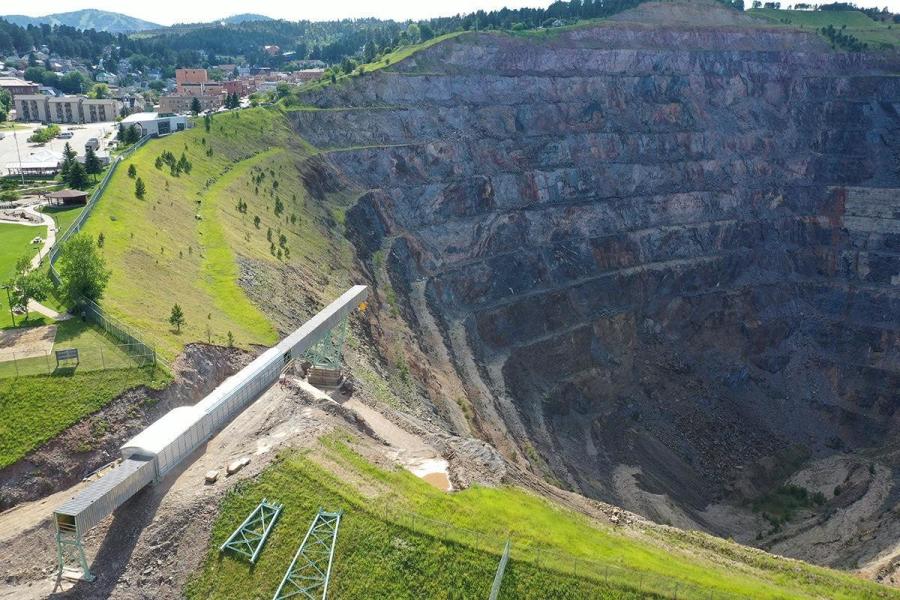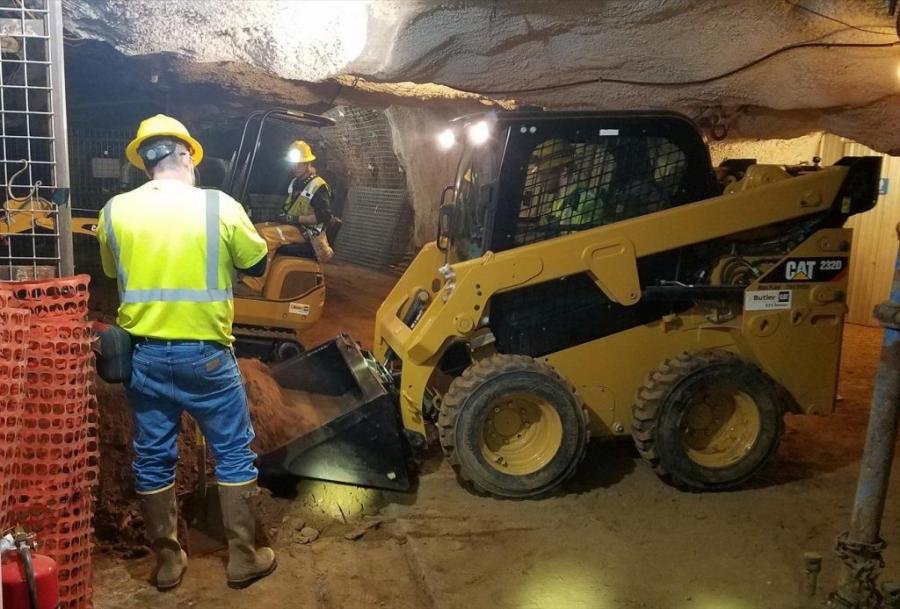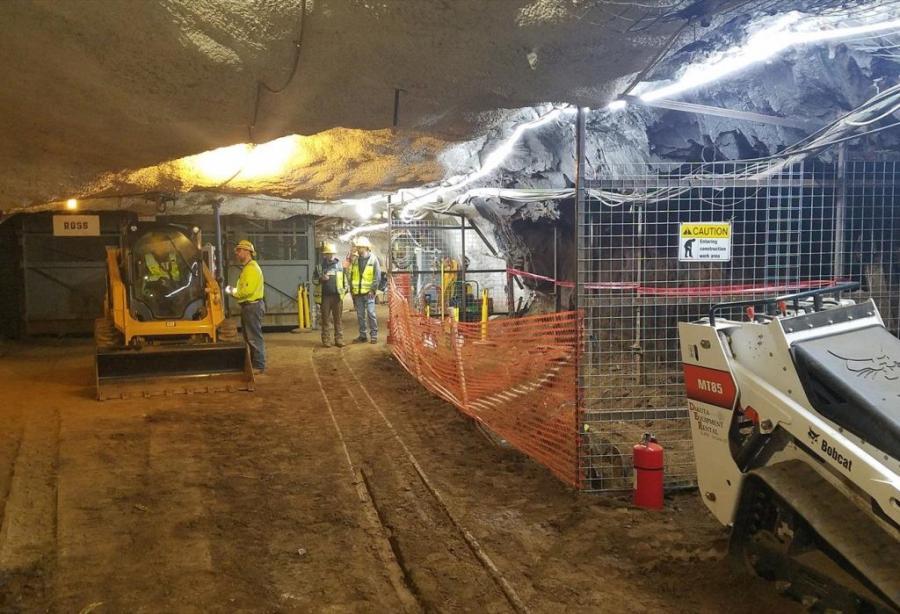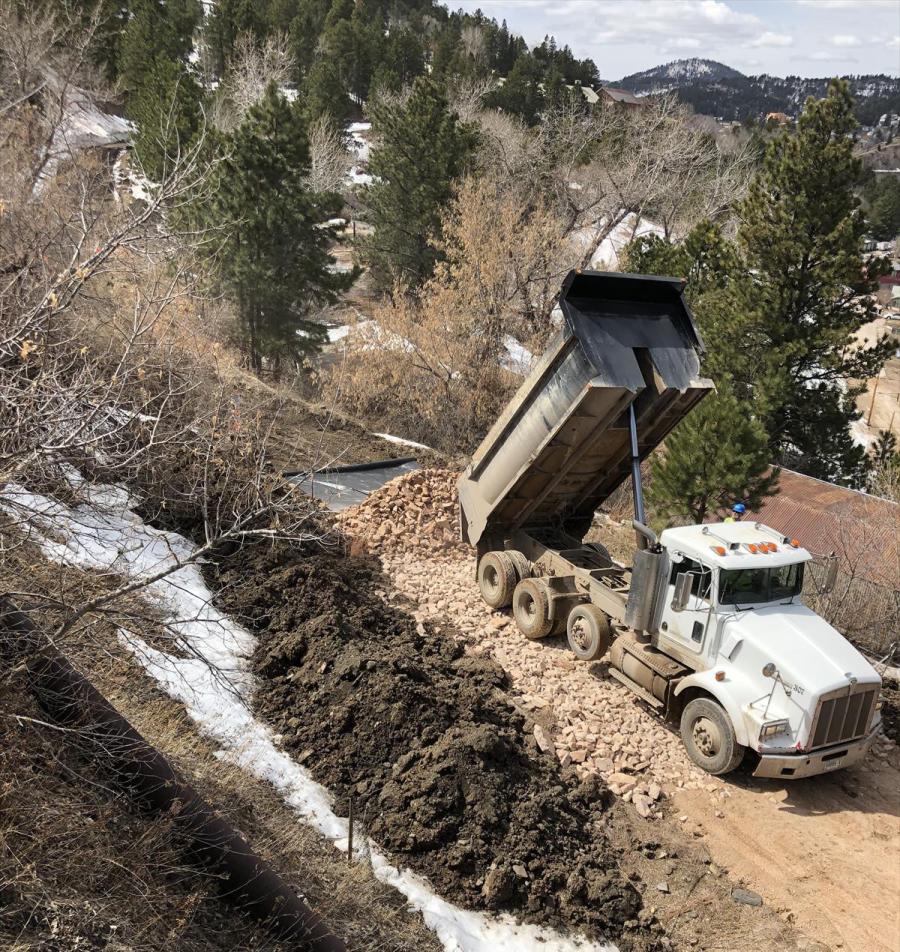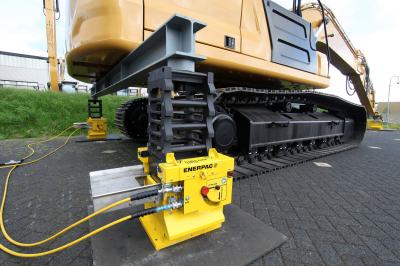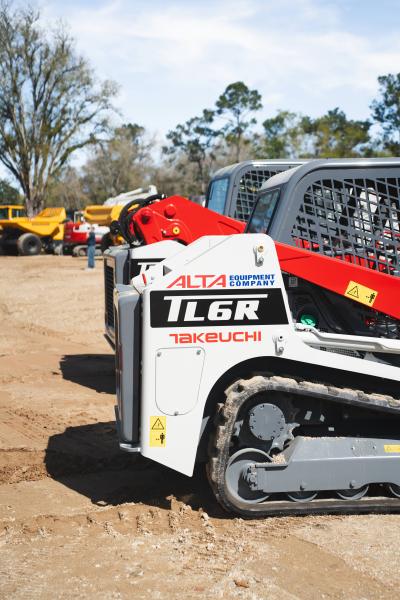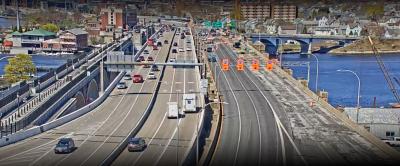An overlook of the open cut, where rock will be deposited from the 4,850-ft. level excavation.
(Sanford Underground Research Facility photo)
International science came to the Black Hills of western South Dakota, because that's where the deep hole is. Over the last century, the hole — Ross Shaft — was sunk 5,000 ft. to give access to lateral tunnels from which gold was extracted from sedimentary rock to a depth of 8,000 ft. Now the opening into the earth is being repurposed into an entranceway for a highly-sophisticated underground physics experiment.
Most of us non-scientists have to wrestle a bit to comprehend the scientific aspect of the project, which is called the Deep Underground Neutrino Experiment, or DUNE. However, the engineering and excavation process involved in the undertaking is more readily comprehensible and quite impressive.
The short version is this: Hundreds of thousands of tons of rock almost a mile below the surface will be drilled and blasted apart using conventional mining machinery. The rubble then will be mechanically conveyed to the surface where it will be further crushed and deposited in a huge pit. The created caverns will be ventilated and cement-floored for the installation of four large scientific instruments. The finely calibrated devices will be used to detect and interpret intense neutrino bursts beamed to them through the earth from a laboratory near Chicago some 800 mi. away.
Scientists from more than 30 participating nations will thus advance their understanding of the class of particles called neutrinos. The particle physics experiment is a futuristic undertaking, to say the least, but the here and now of the excavation work is a wonder, too.
Research Goldmine
Beginning in the late 19th century, the South Dakota site was mined for gold, which was abundantly present, but of low grade. Mine owners kept mucking it out for about 125 years, extracting more than 41 million oz. of the metallic element before closing the last of the operations in 2002. The gold mine became the longest and deepest in North America.
In the 1960s, while still a functioning operation, the underground complex attracted the interest of the international scientific community. A laboratory was set up deep underground to explore the exotic world of solar neutrinos, particles that are constantly blasted to earth from the sun. Years later, a share of the Nobel Prize in physics was awarded the pioneering chemist.
At the turn of this century, the National Science Foundation became interested in additional neutrino exploration at the old mine. In 2006, the South Dakota Science and Technology Authority was formed to own the facility and a year later the Sanford Underground Research Facility came into being. The U.S. Department of Energy and state and private interests fund the enterprise.
The former mine's tunnels and drifts 4,850 ft. beneath the surface attracted more research projects. The current undertaking is the latest one and is happening under the auspices of the U.S. Department of Energy, which funds research through the Fermi National Accelerator Laboratory (Fermilab) in Illinois, the origin of the neutrino beams that eventually will traverse the underground facility. Some 10 years will be devoted just to setting up the sensitive equipment, which then is expected to accumulate neutrino data for 20 years.
Ross Shaft
Ross Shaft is one of two active vertical entranceways to the warren of tunnels blasted out decades ago to mine the gold. In all, some 370 mi. of tunnels were excavated. Most of the research work is occurring at a level 4,850 ft. below the surface. It is there that a section of drifts adjacent to the Ross Shaft will be broadened out into three caverns to house DUNE's research instruments in what is dubbed the Long Baseline Neutrino Facility.
The facility was only a twinkle in some scientist's eye when construction teams began the hard work of turning it into a reality. The initial work was the repair and upgrading of the Ross Shaft. Beginning in 2012, crews began methodically replacing rusted steel-beam structures that framed the 19-ft.-by-14-ft. hole in the ground. Newer generation, higher-tensile steelwork replaced the aging steelwork. Debris that had collected in the shaft was removed.
This reconstruction work was handicapped by the need to keep the shaft operational at the same time it was being refurbished. Construction workers also had to overcome a 1,200-ft. section of the shaft where weaker rock walls had been reinforced with a concrete facing. Decades of subtle ground movement had misaligned some of the concrete to where it inhibited the vertical movement of the rising and descending cage. In places, the workers had to chip away the concrete with hammers to facilitate passage.
Refurbishing the shaft to a depth of nearly a mile took five long years and opened the way for the second phase of work prior to the main excavation.
Room for Drill
At a depth somewhat nearer the surface than the level where the neutrino facility finally will be assembled, an auxiliary component of the excavation is well under way. Last June, Kiewit-Alberici Joint Venture — the project's overall general contractor — began to hand-drill, blast and clear a 60-ft. by 30-ft. room in a drift some 3,650 ft. beneath the opening of the Ross Shaft.
The new chamber created by the contractor will house an industrial raise boring unit, which will be lowered down the shaft in April and assembled in the cleared space. The machine will drill down about 1,200 ft. to the lower level, creating a ventilating pathway for the future chambers. The new shaft will be sunk several thousand feet away from the larger Ross Shaft.
According to James Rickard, the project's resident engineer, an Ingersoll Rand RBM-7 raise bore unit will create the 12-ft.-in-diameter ventilation shaft. A raise bore is a push-pull machine. It first drills a pilot hole. Then, with the string fully extended, a reamer — in this case 12 ft. across — replaces the pilot bit at the lower end and the string is pulled upward by the boring unit. The rising reamer chews out a smoothly walled shaft.
"Boring the shaft will take roughly six months," Rickard said, with the work to begin in April. The reamed shaft will help keep the chamber at a constant temperature for delicate scientific equipment. It also will help remove fumes and heat produced by heavy equipment during actual excavation of the cavern system.
Creating New Chambers
At the 4,850-ft. level is where most of the action will be the next several years, according to Rickard. He is no stranger to underground cavern projects, by the way. An engineering graduate of Camborne School of Mines in the United Kingdom, Rickard was British Petroleum's on-site representative near Zhuhai, China, for the excavation of two chambers for storage of butane and propane. Each of the chambers carved out of subterranean granite has a capacity of more than 260,000 cu. yd. of gas.
The chamber work in South Dakota has been contracted to Thyssen Mining Inc., the U.S. subsidiary of Thyssen Mining Construction of Canada Ltd. Its crews are tasked with creating voids in the earth equivalent in area to two football fields — more than four acres — and up to seven stories high from floor to ceiling. Excavation will begin in April and not wrap up for three years.
Specifically, the two chambers to contain the neutrino detection facilities will be 475 ft. long, 65 ft. wide and 92 ft. high. The cavern dedicated to supporting utilities machinery will be about the same width. However, it will be longer at 624 ft. and lower, with a ceiling of 37 ft.
Rickard characterizes the underground rock formations from which these rooms will be carved as "pretty stable. It's a basic sedimentary rock, a hard schist rock." The walls will be bolted, meshed and shotcreted as needed to further stabilize them.
Unlike the gold miners who began working the South Dakota claim in the 1870s, this will not be a pick, shovel and dynamite operation. Modern mining drill rigs, bolting machines and explosives will do the heavy work. Just getting the jumbo rigs to the working level will be the trick: Thyssen will employ jumbo face-drilling rigs, and they aren't small.
The contractor's Atlas Copco 282, for example, is nearly 10 ft. tall and 40 ft. long with twin booms in place. Without the booms, the 75-hp carrier still is nearly 20 ft. long. Another jumbo drill model expected to be employed by Thyssen is a Sandvik DD422i. The electro-hydraulic jumbo is a 27-ton rig with a carrier fully 25 ft. long.
Comes the question: How do you get the big machines down a shaft 19 ft. at its widest point? Answer: in pieces.
"They will be broken down into components, lowered down the shaft and reassembled," Rickard said.
In all, 11 heavy mobile machines will arrive topside intact and be broken down as necessary into major components. The disassembled parts will be slowly lowered via the pulley system housed in the extensively strengthened headframe serving Ross Shaft. The equipment will be reassembled and regain its functionality 4,850 ft. below ground.
Also included in this piece-meal transfer will be massive bolters and load-haul-dump units. The bolting machines scheduled to work the site are Sandvik DS311DE and DS512i units. The former is a 20-ton machine that can drill and insert expansion bolts up to 10 ft. in length to reinforce the tension in rock walls. Moving the rubble will be the job of four Sandvik LH307 load-haul-dump units. The low-profile LHDs are just under 30 ft. in length and weigh nearly 20 tons. They each have a 7-ton load capacity.
After drilling and blasting, the LHDs will load the rubble and dump it in an ore pass. From there it will move to a pair of hoist skips running to the surface through Ross Shaft. At full operation, 150 tons of rock can be lifted to the surface in an hour — about 3,000 tons a day. Thyssen Mining crews will keep this underground hive humming.
In all, some 800,000 tons of rock will be removed over the next three years. Excavation of the three caverns will occur simultaneously — two to house the neutrino instruments and one for utility equipment — and connecting tunnels.
Topside
The rock hauled to the surface will not create a hill of waste in the Black Hills. After it is hoisted to the surface, the shattered rock will be dumped from the skips into a 300-hp Lippmann jaw crusher, where it will be further reduced to 3 in. or smaller.
From there, the rock will be conveyed through an underground tramway to an enclosed Robbins surface conveyor belt system that will carry the rock over U.S. Highway 85 to a former open-cut mining crevice dating to the 1980s. While dumping about 800,000 tons of rocky refuse into a terraced open pit sounds like a lot, this is a big pit. It is more than 1,200 ft. deep and the excavated tonnage will fill less than one percent of it.
Rickard will oversee the engineering aspects of the project from his office on the surface, with daily trips down Ross Shaft to see progress in the excavation. He will consult with supervisors on site who will keep a constant eye on the digging.
If all goes well, the caverns and tunnels will be a reality in April 2024 and concrete flooring will have been poured. At that point, Thyssen Mining will disassemble its machines and hoist them to daylight. Working with Long Baseline Neutrino Facility managers, Kiewit-Alberici Joint Venture and its subcontractors will fit out the space.
And all is expected to go well, according to Michael Gemelli, construction manager.
"I'm fortunate to have a project team comprised of world-class subject matter experts in deep underground excavation who make safety their focus and priority," he said. "This is a very complex project. It's similar to building a ship in a bottle since everything required to construct and build a large underground laboratory has to be sized according to the shaft."
Gemelli noted that the Lead (pronounced leed) community, with a population of 3,000, is pleased to be a part of the historic scientific project.
"The excavation contractor, Thyssen Mining, has been highly involved in the community. There's been a lot of outreach from contractor to community and everyone is excited. There is much excitement around the project," he said.
Two months before beginning excavation, Thyssen Mining representatives already set up offices in Lead. The 110 employees needed for the caverns dig includes local hires and Thyssen employees transferred to South Dakota for the duration of the project, all of whom will boost the local economy. CEG
Today's top stories



